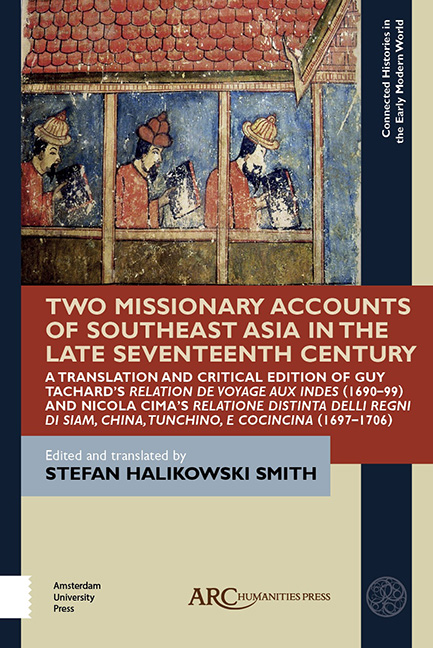 Two Missionary Accounts of Southeast Asia in the Late Seventeenth Century
Two Missionary Accounts of Southeast Asia in the Late Seventeenth Century Book contents
- Frontmatter
- Contents
- List of Illustrations
- Acknowledgements and Aids to Research
- Brief Chronology of the Lives and Movements of Guy Tachard s.j. (1651–1712) and Nicola Agustin Cima O.E.S.A. (1650–1722)
- Introduction
- PART ONE PRESENTATION OF GUY TACHARD S.J., RELATION DE VOYAGE AUX INDES (1690–99)
- PART TWO PRESENTATION OF NICOLA CIMA, O.E.S.A. RELATIONE DISTINTA DELLI REGNI DI SIAM, CHINA, TUNCHINO, E COCINCINA (CA. 1707)
- Bibliography
- Index
The Relation de Voyage aux Indes (1690–99)
Published online by Cambridge University Press: 24 December 2020
- Frontmatter
- Contents
- List of Illustrations
- Acknowledgements and Aids to Research
- Brief Chronology of the Lives and Movements of Guy Tachard s.j. (1651–1712) and Nicola Agustin Cima O.E.S.A. (1650–1722)
- Introduction
- PART ONE PRESENTATION OF GUY TACHARD S.J., RELATION DE VOYAGE AUX INDES (1690–99)
- PART TWO PRESENTATION OF NICOLA CIMA, O.E.S.A. RELATIONE DISTINTA DELLI REGNI DI SIAM, CHINA, TUNCHINO, E COCINCINA (CA. 1707)
- Bibliography
- Index
Summary
WHEN PÈRE GUY Tachard s.j. published accounts of his first two voyages to the Indies in 1686 and 1689 they were instant literary successes. They are essentially both travel accounts, a popular genre amongst the literate readership of late seventeenth-century Europe, but also acts of self-justification related to the crowning events of a career which had gone very quickly from the shadows of the cloister to the dazzle and pomp of some of the greatest and most expensive embassies ever laid on. Tachard, as the Abbé de Lionne had remarked in 1687, was “the very soul of all this action” (l’âme de tout cet envoi). It is thus strange that the subsequent but important Relation de Voyage aux Indes par un Père de la Compagnie de Jésus, 1690–99 remained unpublished, since it would appear from the manuscript's outset that Tachard planned to follow the same stylistic line, desiring to “provide the public with an account of the two journeys to the Indies” (his third and fourth) he had just completed. As we shall see, however, Tachard's career, if not his self-belief, was running out of steam; indeed, it was widely thought right through the nineteenth century that Tachard had died “around 1694.”
Tachard's Relation would only take its rightful place among a number of seventeenth-century French travel texts which have been re-published critically in living memory. Parts of it, admittedly, were published sixteen years ago when they appeared in an article on “Tachard's Last Appearance in Ayutthaya, 1699” by Michael Smithies in the Journal of the Royal Asiatic Society, and the scholar Raphaël Vongsuravatana, as part of his project to resurrect Guy Tachard from what he called in 1994 “forgottenness” (l’oubli), himself translated two pages, paraphrasing the rest in his accomplished biogra phy of Tachard. Smithies is highly prejudiced against Tachard, if not downright sarcastic: when, for example, Tachard writes of the “ardour” that the King of Siam harboured for the receipt of a letter from the King of France, Smithies comments: “a pure fiction on Tachard's part.” Elsewhere, Smithies appears to follow Tachard's contemporary, Robert Challe, in calling Tachard “the evil genius of French involvement in Siam,” a “paranoid schemer infiltrating himself everywhere and being in larger measure responsible for the fiasco of the French adventure in Siam.”
- Type
- Chapter
- Information
- Two Missionary Accounts of Southeast Asia in the Late Seventeenth CenturyA Translation and Critical Edition of Guy Tachard's Relation de Voyage aux Indes (1690–99) and Nicola Cima's Relatione Distinta delli Regni di Siam, China, Tunchino, e Cocincina (1697-1706), pp. 15 - 46Publisher: Amsterdam University PressPrint publication year: 2019


